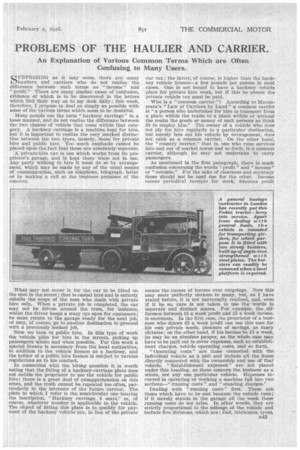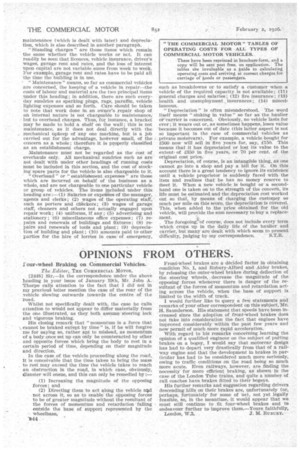PROBLEM'S OF THE HAULIER AND CARRIER.
Page 27

Page 28

If you've noticed an error in this article please click here to report it so we can fix it.
An Explanation of Various Common Terms Which are Often Confusing to Many Users.
SITRPRISING as it may seem, there are many hauliers and carriers who do not realize the difference between such terms as " income " and "profit," There are many similar -cases of 'confusion, evidence of which is to be discovered in the letters which find their way on to my desk daily ; this week, therefore, I propose to deal as simply as possible with some of the various terms which seem to be doubtful.
Many people use the term "hackney carriage" in a loose manner, and do not realize the difference between the two classes of vehicle that come within that category. A hackney carriage is .a machine kept for hire, but it is important to realize the very marked distinction between the two types, namely, those' for private hire and public 'hire. Too much emphasis cannot be placed upon the fact that these are absolutely separate.
A private-hire -car is one which works froth its proprietor's garage, and is kept there when not in use. Any party wishing to hire it must do so by arrangement, which may be made by any of the usual means . of communication, such as telephone, telegraph, letter or by making a call at the business premises of the concern,
What may not occur is for the car to be hired on the spot in the street ; that is casual hire and is entirely outside the scope of the man who deals with private hire only. When a private job is completed, the car may not be driven around the town, for instance, Whilst the driver keeps a wary eye open for customers; he must return to the garage ready for the next job, or may, of course, go to another destination to proceed with a previously booked job.
Now we turn to public hire. In this type of work the vehicle plies for hire in the streets, picking up passengers where and when possible. For this work a special licence is necessary from the local authorities, in addition to the vehicle licence as a hackney, and the holder of a public hire licence is subject to various regulations as to his conduct.
In connection with the hiring question it -is worth noting that the fitting of a hackney-carriage plate does not entitle the proprietor to use the vehicle for public hire; there is a great deal of misapprehension on this score, and the truth cannot be repeated too often, particularly in the interests of the future carrier. The plate to which I refer is the semicircular one bearing the inscription, "Hackney carriage, 6 seats," or, of course, whatever number is applicable to the vehicle. The object of fitting this plate is to qualify for payment of the hackney vehicle tax, in lieu of the private car tax; the latter, of course, is higher than the hack-: ney vehicle licence—a few pounds per annum in most " cases. One is not bound to have a hackney vehicle plate for private hire work, but if this be absent the private vehicle tax must be paid.
Who is a "common carrier "? According to Macnamara's "Law of Carriers by Land" a: common carrier is "a person wile undertakes for hire to transport from a place within the realm to a place within or without the realm the goods or money of such persons as think fit to employ him." The owner of a vehicle who does not ply for hire regularly to a particular destination, but merely lets out his vehicle by arrangement, doesnot rank as a common carrier. On the other hand, the "country carrier," that is, one who runs services into and out of market towns and so forth, is a common carrier, although he may not undertake to carry passengers.
. As mentioned in the first paragraph, there is much confusion concerning the words " profit " and "income" or "revenue." For the sake of clearness and 'accuracy these should not be used one for the other. Income means periodical receipts for work, whereas profit
means the excess of income over outgoings. Now this may seem perfectly obvious to many, but, as I have stated before, it is not universally realized, and, even if it be so, care is not taken to use the words in separate and distinct senses. For example, the difference between i5 a week profit and f5 a week income. is enormous, In the first case, the proprietor of a business who draws 15 a week profit can use this sum for his own private needs, pleasure or savings, as fancy dictates; on the other hand, if his income be 15 a week, he may be an absolute pauper, as the whole sum may have to be paid out to cover expenses, such as establishment charges, vehicle operating costs, and so forth.
"Operating costs" are those connected with the individual vehicle as a unit and include all the items directly connected with the ownership and use of that vehicle. "Establishment expenses" are not placed under this heading, as these concern the business as a whole, not any one particular vehicle. Expenses incurred in operating or working a machine fall into two sections—" running costs " and "standing charges."
Dealing with "running costs" first. These are items which have to be met because the vehicle runs; if it merely stands in the garage all the week these running costs do not arise. In other words, they are strictly proportional to the mileage of the vehicle and include tive divisions, which are fuel, lubricants, tyres, maintenance (which is dealt with later) and depreciation, which is also described in another paragraph.
"Standing charges" are those items which remain the same whether the vehicle works or not. It can readily be seen that licences, vehicle insurance, driver's wages, garage rent and rates, and the loss of interest upon capital are not variable sums from week to week. For example, garage rent and rates have to be paid all. th,e time the building is in use.
• " Maintenance " means, so far as commercial vehicles are concerned, the keeping of a vehicle in repair—the costs of labour and material are the two principal items under this heading ; in addition, there are such everyday sundries as sparking plugs, rags, paraffin, vehicle lighting expenses and so forth. .Care should be taken to note that work done in an owaer's repair shop of an internal nature is not chargeable to maintenance, but to overhead charges. Thus, for instance, a bracket may be made to hold a shelf on the wall ; this is not maintenance, as it does not deal directly with the mechanical upkeep of any one machine, but is a job carried out for the advantage, hoWever small, of the concern as a whole ; therefore it is properly classified as an establishment charge.
Maintenance must not be regarded as the cost of overhauls only. All mechanical sundries such as are not dealt with under other headings of running costs must be included in this section, and the cost of stocking spare parts for the vehicle is also chargeable to it. " Overhead" or " establishtnent expenses " are those which are incurred on behalf of the business as a whole, and are not chargeable to one particular vehicle or group of vehicles. The items included under this heading are :—(1) Salaries or expenses of the manager, agents and clerks ; (2) wages of the operating staff, such as porters and checkers; (3) wages of garage staff, cleaners and others not actually engaged upon repair work ; (4) uniforms, if any ; (5) advertising and stationery ; (6) miscellaneous office expenses; (7) repairs and renewals of buildings and fixtures ; (S) repairs and renewals of tools and plant ; (9) depreciation of building and plant ; (10) amounts paid to other parties for the hire of lorries in ease of emergency,
such as breakdowns or to satisfy a customer when a vehicle of the required capacity is not available; (11) 'general charges and salaries; (12) fire insurance ; (13) health and unemployment insurances ; (14) miscellaneous.
" Depreciation " is often misunderstood. The word itself means "sinking in value" so far as the haulier or carrier is concerned. Obviously, no vehicle lasts for ever ; it wears out or, as sometimes happens, loses value • because it becomes out of date (this latter aspect is not so important in the case of commercial vehicles as private motorcars). For example, a vehicle bought for £500 now will sell in five years for, say, £150. This means that it has depreciated or lost its value to the extent. of £350 in five years, or 70 per cent. of the original cost price.
Depreciation, of course, is an intangible thing, as one cannot go into a shop and pay a bill for it. On this account there is a great tendency to ignore its existence until a vehicle proprietor is suddenly faced with the item and realises that' he has no money reserve to Meet it. When a neivvehicle is bought or a secondhand one is taken on to the strength of the concern, its life must be estimated and the depreciation cost worked out so that, by means of charging the customer so much per mile on this score, the depreciation is covered. This, when added to the price obtained for the old vehicle, will provide the sum necessary to buy a replacement.
• The foregoing, of course, does not include every term which crops up in the daily life of the haulier and carrier, but many are dealt with which seem to present
difficulty, judging by my correspondence. S.T.R.






























